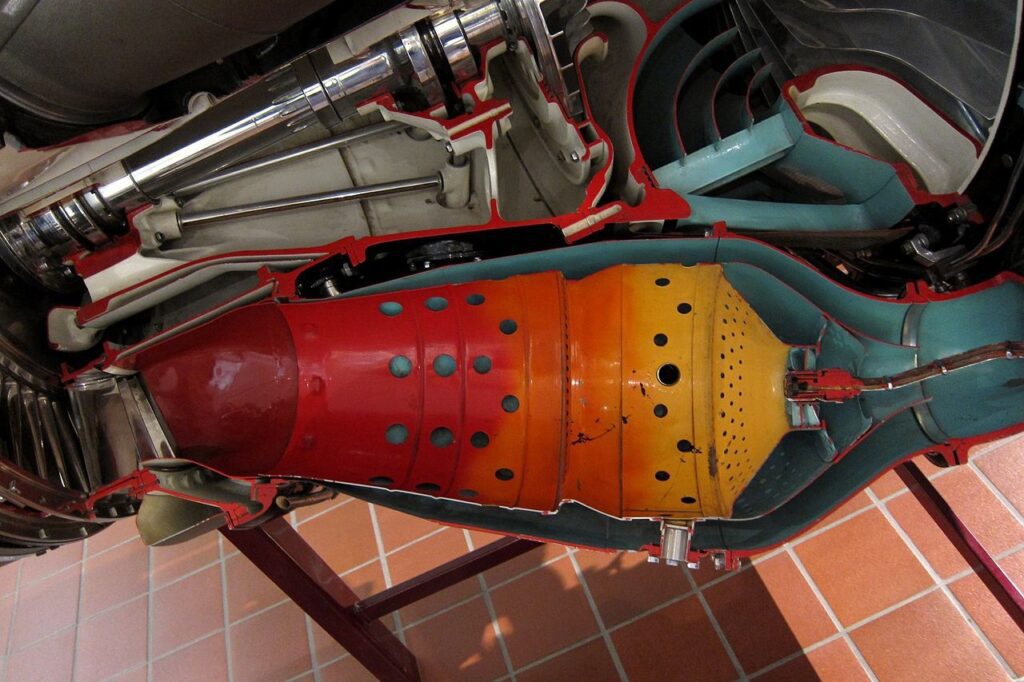Yes.
Gas turbine engine designers jump through hoops to keep that from happening.
They create turbine blades out of special heat resistant, high-strength allows and with holes and internal ducting through which coolant is pumped:
They coat the turbine blades with insulating cermics:
And they carefully control the fuel-air mix, and mix cooling air into the exhaust to control the temperature of the gas hitting the turbine disk:’
Without these steps, or if any of them fail, turbine blades and components can absolutely melt and be ejected from the engine, but it’s rare that it could come to that.
In an overheating engine, assuming a bearing or other key component doesn’t fail, hot corrosion will eat away the turbine blades, causing loss of power and debris shedding at far lower temperatures than required for melting:
Such erosion, along with heat stress, may cause cracks to form and grow until a peice of turbine blade breaks off and becomes a projectile.
Or overheated blades may warp and lose clearance, touching something they shouldn’t and causing rapid, potentially catastrophic mechanical damage.
It’s often said that gas turbines are simpler than internal combustion engines because they only have one moving part. That’s not really true. Aside from the fuel and lubricant pumps, throttle controls and so on, they have many thousands of parts that have to move perfectly together. Let the mixture get too got or let the tip of a turbine blade become eroded enough for the coolant to leak out, and bad things will happen. They might be reparable—but even if they are, they’ll be very, very expensive.
By – C Stuart Hardwick
Award-Winning Scifi Author.
Some Additional Details
Jet engines can reach extremely high temperatures, but they are designed to withstand them. The temperatures inside a jet engine can reach up to 3,000 degrees Fahrenheit, and the materials used in the construction of a jet engine are able to withstand those temperatures. However, it is important to note that if a jet engine were to experience a failure or malfunction, it could potentially lead to a fire or other damage.
Jet engines are complex machines that generate thrust by compressing and combusting air and fuel, and then expelling the resulting gases at high speeds. They are designed to operate under extreme conditions, including high temperatures.
The hottest part of a jet engine is typically the combustion chamber, where fuel is mixed with compressed air and ignited. The combustion process generates intense heat, reaching temperatures that can exceed 2,000 degrees Celsius (3,600 degrees Fahrenheit). The materials used in the construction of jet engines, such as special alloys and ceramics, are carefully chosen to withstand these extreme temperatures.
To protect the engine components from the intense heat, various cooling techniques are employed. One common method is to circulate cooler air from the compressor section around critical components, forming a protective boundary layer. In some cases, the engine may also use advanced cooling techniques, such as film cooling or thermal barrier coatings, to further protect the components.
While jet engines are designed to handle these high temperatures, they are not invulnerable to damage. Extreme conditions, such as a malfunctioning fuel system or a foreign object entering the engine, can lead to a rapid rise in temperature and potentially cause components to fail or melt. Additionally, if the engine is operated outside of its intended parameters or subjected to excessive heat for an extended period, it can lead to thermal damage and degradation of the engine’s performance.
Engineers and manufacturers continually work to improve the materials and designs of jet engines to enhance their durability, efficiency, and safety. Rigorous testing and inspection procedures are also in place to ensure that engines can withstand the demanding conditions they encounter during operation.






